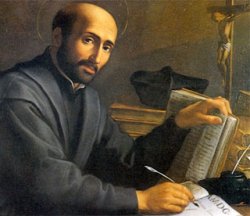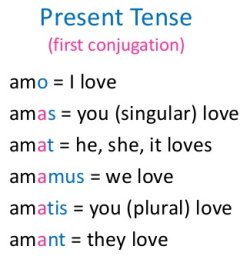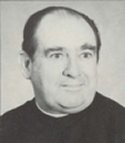High school is different. Continue reading
We were so lucky. Our class was the first freshman class at Rockhurst High in the new building at 9301 State Line Road. That meant that none of the upperclassmen were any more familiar with the layout of the new place than we were. Nobody tried to sell us an elevator pass. I made my way to my homeroom, #204, on a September morning in 1961.
Rockhurst has always been an all-male school. In 2020 Rockhurst High School is still in the same location, and it is thriving. The tuition is over $14,000 per year, as opposed to $300 in the sixties. There are now about a thousand students, an increase of roughly 25 percent.
Rockhurst is a Jesuit institution. The Society of Jesus was founded by a Spaniard, St. Ignatius Loyola. Pope Paul III approved the order in 1540. In the last few centuries the Jesuits became primarily known as educators. Rockhurst was certainly one of the best high schools of any type in the KC area.
About half of the teachers in my day were Jesuits, almost all of them from St. Louis. Many were “scholastics”, i.e., Jesuits who had not yet been ordained as priests. We students called them “mister” just as we did the laymen, but they dressed in black cassocks as did the priests. There might have been one female who taught typing. I say “might” because, by a strange twist of fate, typing was never offered to my class. In 2020 there are very few Jesuits at Rockhurst. The theology department, with a total faculty of thirteen, has only one! There are more than a dozen female teachers, including two department chairs.
One person in my freshman class was black. He played no sports, and he was never in any of my classes. I don’t remember his name. The other three classes had none, and none of the subsequent classes (while I was there) had any. Rockhurst High in 2020 had a considerable number of black students. I don’t know how many were athletes.
In the sixties a considerable number of blacks lived in KC on both sides of the state line, but I have no idea how many were Catholics. At any rate, the new school was on the far southern edge of the city, ninety blocks from downtown. I doubt that there was overt discrimination, but most of the blacks probably went to KC public schools. They might have had trouble with the entrance exam.
The freshmen class was divided into six groups, as designated by six homeroom numbers, based on test scores. We all took classes in the same subjects: religion, English, algebra, health, world history, phys ed, and, of course, Latin. So, everyone whose homeroom was 204 had no classes at all with anyone from any other homeroom. In subsequent years only minor adjustments were made to the groups. By junior year the schedules were more varied, but at the end of four years I had been in classes with less than 25 percent of the 200 or so guys in the class of ’66. So, there were many that I did not know at all.
From day one it was obvious that the classroom experience would be fundamentally different from the educations that most of us had received from the nuns. The only thing that seemed familiar was that we sat in alphabetical order so that the teacher need not waste time calling roll every day.
Discipline was strict, but there were very few incidents. Nearly everyone who attended wanted to be there and appreciated the value of the environment and the education. Each of us was issued a demerit card. Demerits were punched by faculty or staff. If you were given five demerits in a semester, you got a “jug”, which meant that you stayed after school. I got a few demerits over the years but only one jug. That occurred when Mr. Rothermich, SJ, got annoyed with me for practicing basketball moves with my rolled-up stocking cap in the speech room after school.
 We had a dress code that prohibited sneakers, sandals and the like, jeans, and shorts. Shirts had to have collars and buttons. The most popular style of shoe was black leather with pointed toes (roach-killers). Facial hair was out. No hair was allowed on the collar, ears, or forehead. That was fine for the first year and a half, but in February of 1964 guess what happened.
We had a dress code that prohibited sneakers, sandals and the like, jeans, and shorts. Shirts had to have collars and buttons. The most popular style of shoe was black leather with pointed toes (roach-killers). Facial hair was out. No hair was allowed on the collar, ears, or forehead. That was fine for the first year and a half, but in February of 1964 guess what happened.1
We were not required to attend mass every day, but we did write AMDG (Ad Maiorem Dei Gloriam) and BVMH (Beatae Virginis Mariae Honore)
In the first religion class Father Bauman, the vice-principal, began by walking up and down the aisles asking various students a question none of us had considered: “The bible, book or books?” The right answer is definitely “books”, but I bet that a lot of devout Christians would get it wrong. The message was simple. We were not going to memorize the catechism any more; we were going to learn the basis for our common religion.
In the very first Latin class Mr. Kister, SJ, wrote the following sentence on the wall “The gloppy glop glopped the glop gloppily.” The purpose was to show that even in English, which is a word-order language, word endings are often used to identify the nature of individual words. Gloppy is clearly an adjective, glopped is a past-tense verb, and gloppily is an adverb. In Latin word-endings are everything. Mastering Latin is largely a matter of learning to look for and listen for word-endings. Once again, we were being taught to think and understand, rather than memorize. Latin was my favorite class for the first two years. It was edged out by Greek the last two years.
Mr. Stark’s world history class was a little different. He made us memorize this six-phrase list: pencil, pen, eraser, assignment book, folder, paper. We were required to have them at all classes. Every so often he would require us to lay out all six items on our desk for inspection. A demerit was punched for each missing item. Fairly often an eraser would be launched by a student who had already passed inspection in the direction of someone yet to be checked.
Mr. Stark also gave a quiz every day. Everyone hated this, but I think that it was a good idea. I, for one, would probably have put off reading or just skimmed the assigned lessons until right before the test if he had not done so. When I taught at Wayne State, I borrowed this technique.
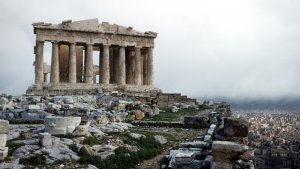 Mr. Stark, who died in 2008, was not my favorite person, but I appreciated his dedication. The one thing that I did not like was when he showed us slides of Greek and Roman ruins. Many years later I saw most of these in person, and even then I found them tiresome after a while. Looking at someone else’s photos got old really fast.
Mr. Stark, who died in 2008, was not my favorite person, but I appreciated his dedication. The one thing that I did not like was when he showed us slides of Greek and Roman ruins. Many years later I saw most of these in person, and even then I found them tiresome after a while. Looking at someone else’s photos got old really fast.
I never thought about this much, but I did not really like Mr. Stark or Mr. Ryan, the basketball coach who also taught American history, a required course for sophomores. I respected both of them, and I took all the history courses offered at Rockhurst, but I did not even consider enrolling in history classes in college. Many years later I became really interested in papal history, and by extension Italian history, and by extension European history. In fact I became obsessed with these subjects. I think that I could have been a really good historical researcher, writer, and teacher. Oh, well, that ship has sailed.
What I remember most about the algebra class taught by Mr. Sisler, SJ, was his peculiar lisp, which, I suspect, came from a slight German accent. One day he asked a question, and I volunteered an answer. He then wrote it on the board and said, “Mistuh Ravada gave us this run to twy” with all the r and w sounds reversed. Not many students sniggered, but everyone talked about it after class.
Nevertheless, he was quite good at teaching algebra. However, he disappeared after our freshman year. I don’t know where he went.
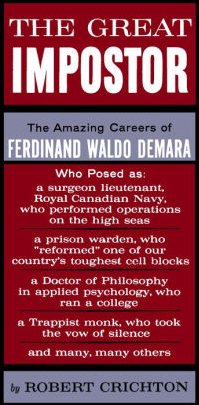 By far the weakest of our teachers was a priest, whose name was, if memory serves, Father Wallace. He taught English, and sometimes he actually dozed off in class. We read nine or ten books throughout the year. The selection was not that stellar
By far the weakest of our teachers was a priest, whose name was, if memory serves, Father Wallace. He taught English, and sometimes he actually dozed off in class. We read nine or ten books throughout the year. The selection was not that stellar—he had a penchant for westerns. He also made a mistake in ordering one book. He ordered The Great Impostor, the biography of Ferdinand Waldo Demara, when he meant to order a novel with a similar title. So, we wasted a few weeks talking about Tony Curtis. I don’t remember this priest being around in subsequent years, either.
I am not sure why, but we also read Mutiny on the Bounty, the non-fiction book by Nordhoff and Hall that has been made into several movies. I remember that after we had supposedly been reading it for a week or so, Father Wallace asked someone whether the sailors made it back to England. The guy whom he asked said that he had not finished the book. Eventually, when it was explained that the answer was on the first page, he had to admit that he had actually not read any of it.
When we were assigned to write a short story, mine was about two twins named Judy and Jody and how they treated their dog. I wasn’t very proud of it, but my classmates voted it the best. I was quite surprised.
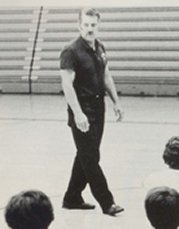 Phys ed was fun. Coach Tuchness, who died in 2014, had us do all kinds of interesting stuff: wrestling, marine basketball (no fouls called), tumbling, crab walks, and regular games. The best part was that he did not make us try to climb a rope. I was one of the few guys who could do a headstand out of a backward roll. I found out that my peculiar spider-shaped build with amazingly flexible wrists was ideal for both types of crab walks. In either type of crab walk race, I was unbeatable.
Phys ed was fun. Coach Tuchness, who died in 2014, had us do all kinds of interesting stuff: wrestling, marine basketball (no fouls called), tumbling, crab walks, and regular games. The best part was that he did not make us try to climb a rope. I was one of the few guys who could do a headstand out of a backward roll. I found out that my peculiar spider-shaped build with amazingly flexible wrists was ideal for both types of crab walks. In either type of crab walk race, I was unbeatable.
Coach Tuchness set up a wrestling match between Pat Dobel and me. We were both built like spiders. He was slightly taller and heavier than I was, but I really thought that I could take him. We wrestled for what seemed like a really long time, and once I almost flipped him. However, neither of us could pin the other. Coach called it a draw.
Rockhurst graded on a 100-point scale. I don’t remember any individual grades, but my average was over 90, which qualified me for “first honors.” The teachers at the Rock were tough graders, but I finished in the top ten of my class in all sixteen quarters. Where is my scholarship?
1. I found a copy of a yearbook from 1975 online. By then the hair standards had been considerably relaxed.


